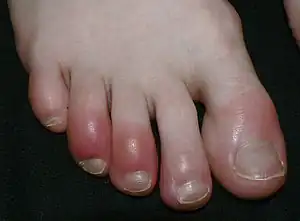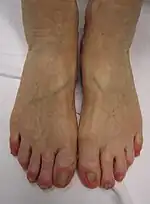Chilblains
| Chilblain | |
|---|---|
| Other names: Pernio,[1] perniones,[2] perniosis,[1] kibes[3] | |
 | |
| Toes inflamed by chilblains | |
| Pronunciation |
|
| Specialty | Emergency medicine |
| Symptoms | Redness, itching, blistering[4] |
| Usual onset | Within a few hours[1] |
| Duration | 1 to 2 weeks[1] |
| Causes | Prolonged cold exposure[5] |
| Risk factors | Lupus, smoking, family history, Raynaud's[1] |
| Diagnostic method | Based on symptoms and examination[6] |
| Differential diagnosis | Frostbite, trench foot, leukemia cutis, cold panniculitis[5][7][8] |
| Prevention | Keeping the hands and feet warm[1] |
| Treatment | Corticosteroid creams[1] |
Chilblains, also known as pernio, is a type of cold injury that results in red, itchy, and tender areas of skin.[1][4] Less commonly blistering and ulceration may occur.[4] The fingers, toes, ears and cheeks are most commonly affected.[4]
Chilblains typically occurs due to prolonged exposure to cold.[5][8] The degree of cold; however, is less than freezing, which would result in frostbite.[5] Risk factors include lupus, smoking, family history, and Raynaud's.[1] The underlying mechanism involves the inflammation of small blood vessels.[1][4] Diagnosis is usually based on symptoms and examination.[6]
Prevention is generally by keeping the hands and feet warm.[1] Other measures may include avoiding caffeine and potentially taking nifedipine.[1] Treatment may involve the use of corticosteroid creams.[1] It may take a week or two for an episode to resolve.[1]
Chilblains is relatively common in regions of the world with cold climates.[8] The young and old are most commonly affected.[1] Women are more commonly affected than men.[8] The condition has been described since at least the 1st century by Pedanius Dioscorides of Anazarbus.[9]
Signs and symptoms
The areas most affected are the toes, fingers, earlobes, nose.[1]
- Blistering of affected area
- Burning and itching sensation in extremities
- Dermatitis in extremities
- Ulceration (severe cases only)
- Erythema (blanchable redness of the skin)
- Pain in affected area
- Skin discoloration, red to dark blue
Chilblains caused by exposure to low temperatures usually heal within 7–14 days.
.jpg.webp) Chilblains
Chilblains.jpg.webp) Lupus chilblains
Lupus chilblains.jpg.webp) Lupus chilblains
Lupus chilblains Chilblains from excessively icing the feet
Chilblains from excessively icing the feet
Diagnosis
Diagnosis is usually based on symptoms and examination.[6]
Differential diagnosis
In infants affected by Aicardi–Goutières syndrome (a rare inherited condition which affects the nervous system) chilblain-like symptoms occur together with severe neurologic disturbances and unexplained fevers.
Chilblain-like symptoms have also been linked to COVID-19.[10][11][12] COVID toes, as they are commonly known,[13][14] have mostly been reported in older children and adolescents,[15] who often have not had other symptoms of COVID-19.[16] The symptoms are usually mild and disappear without treatment.[15] Their cause is debated: it is uncertain whether COVID toes are a delayed consequence of the viral infection itself (or at least partially connected to environmental factors during the COVID-19 pandemic).[13][14][17] They may share some of the microscopic features of chilblains caused by lupus.[16] It has been suggested that in the absence of exposure to cold and damp, COVID-19 should be considered as a possible cause of chilblains.[16]
Prevention
Exposure
Other
Treatment
Treatment for the condition depends on its cause. Below are some common treatments for chilblains caused by exposure to low temperatures, though some may also apply to other sources of the condition.
- Soaking in warm water with Epsom salts for 15–20 minutes, 3–4 times a day.
- A topical steroid cream may relieve itching.
- Nifedipine, a vasodilator, may help in some cases,[21] and can be used throughout just the winter months.[1] Vasodilation may reduce pain, facilitate healing, and prevent recurrences.[22] It is typically available in an oral pill but can be compounded into a topical formula.
- Diltiazem, a vasodilator, may help.[23]
- Apply a mixture of friar's balsam and a weak iodine solution.[19]
- Avoid restricting the affected area.[24]
History
The medieval Bald's Leechbook recommended treating chilblains with a mix of eggs, wine, and fennel root,[25] and a modern home remedy is to put garlic on the chilblains.[26] Neither of these remedies has been supported by scientific research.
See also
References
- 1 2 3 4 5 6 7 8 9 10 11 12 13 14 15 16 17 "Chilblains". DermNet NZ. Archived from the original on 2 December 2020. Retrieved 1 December 2020.
- ↑ Killian, H. (2012). Cold and Frost Injuries — Rewarming Damages Biological, Angiological, and Clinical Aspects: Biological, Angiological, and Clinical Aspects. Springer Science & Business Media. p. PT43. ISBN 978-3-642-67051-0. Archived from the original on 2021-08-28. Retrieved 2020-12-01.
- ↑ Bolognia, Jean L.; Jorizzo, Joseph L.; Schaffer, Julie V. (2012). Dermatology E-Book. Elsevier Health Sciences. p. 1493. ISBN 978-0-7020-5182-1. Archived from the original on 2021-08-28. Retrieved 2020-12-01.
- 1 2 3 4 5 "Cold Related Illnesses". www.cdc.gov. 21 February 2020. Archived from the original on 17 October 2020. Retrieved 1 December 2020.
- 1 2 3 4 Stanley, James C.; Veith, Frank; Wakefield, Thomas W. (2014). Current Therapy in Vascular and Endovascular Surgery E-Book. Elsevier Health Sciences. p. 701. ISBN 978-1-4557-5962-0. Archived from the original on 2021-08-28. Retrieved 2020-12-01.
- 1 2 3 Wigley, Fredrick M.; Herrick, Ariane L.; Flavahan, Nicholas A. (2014). Raynaud’s Phenomenon: A Guide to Pathogenesis and Treatment. Springer. p. 168. ISBN 978-1-4939-1526-2. Archived from the original on 2021-08-28. Retrieved 2020-12-01.
- ↑ Patterson, James W. (2019). Weedon's Skin Pathology E-Book. Elsevier Health Sciences. p. 290. ISBN 978-0-7020-7583-4. Archived from the original on 2021-08-28. Retrieved 2020-12-01.
- 1 2 3 4 Bonamigo, Renan Rangel; Dornelles, Sergio Ivan Torres (2018). Dermatology in Public Health Environments: A Comprehensive Textbook. Springer. p. 27. ISBN 978-3-319-33919-1. Archived from the original on 2021-08-28. Retrieved 2021-02-18.
- ↑ Cartwright, Anthony C.; Armstrong, N. Anthony (2020). A History of the Medicines We Take: From Ancient Times to Present Day. Pen and Sword History. p. PT274. ISBN 978-1-5267-2404-5. Archived from the original on 2021-08-28. Retrieved 2020-12-01.
- ↑ Wollina U, Karadağ AS, Rowland-Payne C, Chiriac A, Lotti T (2020). "Cutaneous signs in COVID-19 Patients: a review". Dermatologic Therapy: e13549. doi:10.1111/dth.13549. PMC 7273098. PMID 32390279.
- ↑ Young S, Fernandez AP (2020). "Skin manifestations of COVID-19". Cleveland Clinic Journal of Medicine. doi:10.3949/ccjm.87a.ccc031. PMID 32409442.
- ↑ Kaya G, Kaya A, Saurat JH (June 2020). "Clinical and histopathological features and potential pathological mechanisms of skin lesions in COVID-19: review of the literature". Dermatopathology. 7 (1): 3–16. doi:10.3390/dermatopathology7010002. PMID 32608380.
In acral chilblain-like lesions, a diffuse dense lymphoid infiltrate of the superficial and deep dermis, as well as hypodermis, with a prevalent perivascular pattern and signs of endothelial activation, are observed.
- 1 2 Massey PR, Jones KM (May 2020). "Going viral: A brief history of chilblain-like skin lesions ("COVID toes") amidst the COVID-19 pandemic". Seminars in Oncology. doi:10.1053/j.seminoncol.2020.05.012. PMID 32736881.
- 1 2 Bristow IR, Borthwick AM (June 2020). "The mystery of the COVID toes – turning evidence-based medicine on its head". Journal of Foot and Ankle Research. 13 (1): 38. doi:10.1186/s13047-020-00408-w. PMC 7309429. PMID 32576291.
- 1 2 Walker DM, Tolentino VR (June 2020). "COVID-19: The impact on pediatric emergency care". Pediatric Emergency Medicine Practice. 17 (Suppl 6-1): 1–27. PMID 32496723. Archived from the original on 2020-06-26. Retrieved 2020-06-23.
- 1 2 3 Ladha MA, Luca N, Constantinescu C, Naert K, Ramien ML (August 2020). "Approach to chilblains during the COVID-19 pandemic". Journal of Cutaneous Medicine and Surgery: 1203475420937978. doi:10.1177/1203475420937978. PMID 32741218.
- ↑ "Unusual coronavirus (COVID-19) symptoms: What are they?". Archived from the original on 2021-08-16. Retrieved 2020-07-21.
- 1 2 Harvard.edu. "Archive copy". Archived from the original on 27 July 2020. Retrieved 31 May 2020.
{{cite web}}: CS1 maint: archived copy as title (link) - 1 2 3 4 5 "What are chilblains (pernio)? What causes chilblains?". Medical News Today. Archived from the original on 2011-09-06. Retrieved 2011-08-11.
- ↑ "Chilblains.org – #1 Online Source for Treatments, Prevention, Relief Advice". Chilblains.org. Archived from the original on 2014-11-24. Retrieved 2021-11-21.
- ↑ Rustin, M.H.A.; Newton, Julia A.; Smith, N.P.; Dowd, Pauline M. (2006). "The treatment of chilblains with nifedipine: the results of a pilot study, a double-blind placebo-controlled randomized study and a long-term open trial". British Journal of Dermatology. 120 (2): 267–75. doi:10.1111/j.1365-2133.1989.tb07792.x. PMID 2647123.
- ↑ Simon, T. D.; Soep, JB; Hollister, JR (2005). "Pernio in Pediatrics". Pediatrics. 116 (3): e472–5. doi:10.1542/peds.2004-2681. PMID 16140694.
- ↑ Patra, AK; Das, AL; Ramadasan, P (2003). "Diltiazem vs. nifedipine in chilblains: A clinical trial". Indian Journal of Dermatology, Venereology and Leprology. 69 (3): 209–11. PMID 17642888. Archived from the original on 2020-07-27. Retrieved 2021-11-21.
- ↑ "Chilblains.com.au – Information, Treatment and Prevention". Archived from the original on 2016-03-05. Retrieved 2019-11-06.
- ↑ Robert Lacey and Danny Danziger August: The Year 1000: What Life Was Like at the Turn of the First Millennium Little, Brown, 2000 ISBN 0316511579
- ↑ "Remedios caseros para sabañones". saludplena.com (in Spanish). Archived from the original on 1 February 2017. Retrieved 29 December 2016.
{{cite web}}: CS1 maint: unrecognized language (link)
External links
| Look up chilblains in Wiktionary, the free dictionary. |
- DermAtlas 1683395337
- Cold stress Archived 2012-08-11 at the Wayback Machine, National Institute for Occupational Safety and Health
| Classification | |
|---|---|
| External resources |